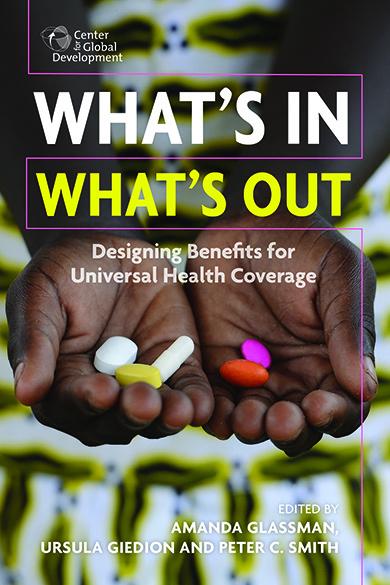Vaccinate children against measles and mumps or pay for the costs of dialysis treatment for kidney disease patients? Pay for cardiac patients to undergo lifesaving surgery, or channel money toward efforts to prevent cardiovascular disease in the first place?
For universal health care (UHC) to become a reality, policymakers looking to make their money go as far as possible must make tough life-or-death choices like these.
Many low- and middle-income countries now aspire to achieve universal health coverage, where everyone can access quality health services without the risk of impoverishment. But for universal health care to work in practice, the health services offered must be consistent with the available funds, and this implies very difficult decisions—particularly for low- and middle-income countries that are resource-constrained, but where demand for high-quality health services and technologies is increasing rapidly.
In collaboration with iDSI, we’re launching a new book, What’s In, What’s Out: Designing Benefits for Universal Health Coverage. It shows how a defined list of services that will be funded with public monies (called a “health benefits package” or HBP—known in the US as “essential benefits”) can help bridge the gap between the aspirational rhetoric of universal health care and the real budgetary limitations that many countries face. A good HBP should be practical and made in consideration of the fiscal, human resource, infrastructural, and geographic constraints of that setting. When done well, the HBP defines the health services a government can deliver, and ensures health services are fairly and equitably delivered to citizens—and are cost-effective.
Leading experts and policymakers from more than 15 countries contributed to the book. Together, they consider the many dimensions of governance, budgets, methods, political economy, and ethics that are needed to decide “what’s in and what’s out” of a HBP in a way that is fair, evidence-based, and sustainable over time.
Key Takeaways:
Set fair and transparent processes to select, revise, implement, and monitor the HBP.
Not only does the creation of a HBP include the work of designing a sustainable benefits package by using methods exercises to identify the services that will be financed with public resources, but it also requires updating, monitoring, evaluating, and implementing. Like the package itself, the design process for the HBP must be consistent with time, financial, and human resources available. Inclusion or exclusion of specific medical interventions can have life-or-death consequences for specific groups, but the establishment of a fair and technically sound process for priority-setting can help increase overall public buy-in. Adherence to good governance principles during the HBP design process—transparency, consistency, and stakeholder participation—helps sensitize stakeholders to the rationale for setting limits and can thus improve the package’s legitimacy and sustainability.
Use rigorous methods to get the most health for your money.
Since the HBP requires tough decisions, the design process must be thorough and it requires the necessary resources to ensure fairness and technical rigor. Not only does a benefits package need to be explicit, but for it to work properly, its components must be selected by consistently applying an explicit set of criteria. Cost-effectiveness analysis allows a country to rank different interventions and select treatments that will achieve the most health for the given budget. The cost-effectiveness threshold will vary according to context-specific factors. While simple cost-effectiveness analysis only considers health gain, a range of more sophisticated methods account for other factors, including financial risk protection, health systems constraints, equity considerations, and more.
Manage the ethical, legal, and political implications of inclusion and exclusion decisions.
When making the hard choices to decide what’s in and what’s out of a HBP, political, legal, and ethical stakes are high. Policymakers should be sure to consider ethical implications throughout the HBP design and adjustment process. They should try their best to include fair processes and procedures, avoid harms to individual patients, and offer respect and dignity for patients.
Rather than a technical manual for conducting health technology assessments or cost-effectiveness analysis, this book puts HBP development and design methods into a broader context and considers how these methods may be applied to coverage decisions in low- and middle-income countries. It offers a collection of views and perspectives, and also provides real-life examples of HBP design and adjustment in order to show the diverse approaches to priority-setting around the world.
We’ve learned a lot from compiling this book and we’re excited to share these lessons with you. We encourage you to check out our webpage and to order your copy of the book. We also hope you’ll join us on Wednesday, October 11 for a policy breakfast to celebrate the book’s release. We’ll hear from Ole Norheim, Tim Evans, and Eduardo Gonzalez-Pier on their experiences in running benefits plans policies around the world, and how the book and related efforts can help to translate UHC from rhetoric to reality.
You can RSVP to the event here.
Disclaimer
CGD blog posts reflect the views of the authors, drawing on prior research and experience in their areas of expertise. CGD is a nonpartisan, independent organization and does not take institutional positions.






